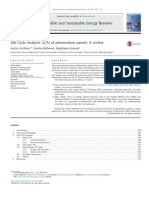First Solar Answer
Uploaded by
Eleonora SalvagnoFirst Solar Answer
Uploaded by
Eleonora SalvagnoFirst Solar
PROBLEMS
Market demand for PV panels is weakening
Crystalline silicon was the dominant technology in the market
Variability of material prices: silicon raw material prices were also falling helping First Solar’s
competitors, which produced silicon-based panels, but not First Solar, which produced cadmium
telluride-based ones.
China’s photovoltaic: the increasing market share of Chinese competitors led to First Solar
producing only 1.7 gigawatts of panels despite having the capacity to produce 2.5 gigawatts
European countries significantly reduce the incentives and subsidies
High SG&A expenses: selling, general and administration costs raised after the acquisitions
Dependence from Europe specially Germany
PRO
Panels using thin film were typically lower cost and required 98% less semiconductor material
than traditional c-Si panels. In 2011, cadmium telluride use in thin film solar panels was
approximately 0.1 grams per watt. Lot of R&D invested for overcome the obstacles and technical
challenges deriving from thin film cadmium telluride
China manufactures were largely absent in the system business
Less borrowings than the others
Controlling all stages of production entirely in-house
Geographic diversification: establishment in tactic areas in terms of logistic, stockage and prices
Thin film cells while cheaper are generally less efficient than polysilicon cells but have lower
production costs, making them more attractive from a financial perspective
ACTION PLAN
Was the systems business a competitive advantage or a distraction?
Through its systems business, First Solar controlled the engineering, procurement, construction,
operations, maintenance, and development of solar power plants, and at times, project finance
If First Solar was forced to retrench, which market should the company focus on, and would it be
able to prevail in that market?
components segment had historically achieved higher profitability and generated more cash
than systems, but the systems business had less margin variability because the provision of
ongoing maintenance, engineering, and construction was less dependent on materials prices.
Chinese manufacturers were largely absent from the systems business.
more independence from Germany, so trying to diversifying in other countries
Focus on utility and residential market
More system than components (around 60% and 40% maybe(?))
If we are forced to retrench, we can “steal a deal” with companies that provide services and
return to the model business of 2006 because we know how to do that, how to sell it and to
whom, and people know us
You might also like
- Toledo Solar - Investor Deck 21 122TN (Optimized)No ratings yetToledo Solar - Investor Deck 21 122TN (Optimized)48 pages
- Modeling Guide For First Solar Thin Film TechnologyNo ratings yetModeling Guide For First Solar Thin Film Technology47 pages
- International Technology Roadmap For PhotovoltaicsNo ratings yetInternational Technology Roadmap For Photovoltaics39 pages
- A Novel Zig Zag Scheme For Power Enhancement of Partially Shaded Solar Arrays 2016 Solar EnergyNo ratings yetA Novel Zig Zag Scheme For Power Enhancement of Partially Shaded Solar Arrays 2016 Solar Energy11 pages
- Caroline Tjengdrawira Best Practices Guidelines For EPC and O M PDFNo ratings yetCaroline Tjengdrawira Best Practices Guidelines For EPC and O M PDF15 pages
- Canadian Solar MaxPower CS6U P Solar Panel DatasheetNo ratings yetCanadian Solar MaxPower CS6U P Solar Panel Datasheet2 pages
- PHOTON International 2016-07 Will It WorkNo ratings yetPHOTON International 2016-07 Will It Work84 pages
- LOI For RVA Solar Fund PPA.2018.Nonprofit - FillableNo ratings yetLOI For RVA Solar Fund PPA.2018.Nonprofit - Fillable19 pages
- Trina Tracker Presentation Neoventure Jan 2021No ratings yetTrina Tracker Presentation Neoventure Jan 202130 pages
- IEEE - Solar Forecasting - Methods Challenges and PerformanceNo ratings yetIEEE - Solar Forecasting - Methods Challenges and Performance10 pages
- Project Report ON Solar Tile: Submitted ToNo ratings yetProject Report ON Solar Tile: Submitted To31 pages
- GE EVN Solutions For Power and Utilities From GE DigitalNo ratings yetGE EVN Solutions For Power and Utilities From GE Digital21 pages
- 03 - LONGi Solar-Bifacial Technology and HiMO4 New Series-MinNo ratings yet03 - LONGi Solar-Bifacial Technology and HiMO4 New Series-Min30 pages
- Lab Report - Part A: Kanvasree Vuyyuru (C2084903)No ratings yetLab Report - Part A: Kanvasree Vuyyuru (C2084903)8 pages
- Compare Solar Panels - A Side-By-Side ComparisonNo ratings yetCompare Solar Panels - A Side-By-Side Comparison28 pages
- Solar Enery and Factors Affecting The Efficiency and Performance o Panels100% (1)Solar Enery and Factors Affecting The Efficiency and Performance o Panels9 pages
- Mono Crystalline PERC Silicon Solar PV Modules - 60No ratings yetMono Crystalline PERC Silicon Solar PV Modules - 602 pages
- Floating Solar Power Plant - Google ScholarNo ratings yetFloating Solar Power Plant - Google Scholar2 pages
- SynaptiQ User Manual - Annex A Definition of IndicatorsNo ratings yetSynaptiQ User Manual - Annex A Definition of Indicators14 pages
- Solar Panel Automated Cleaning Using Water Re-Capture and Re-Circulation SystemNo ratings yetSolar Panel Automated Cleaning Using Water Re-Capture and Re-Circulation System11 pages
- Solar Power Procurement Related Issues Order-TNERC-16-10-2020No ratings yetSolar Power Procurement Related Issues Order-TNERC-16-10-202047 pages
- SolarPro - 8.5 Performance Modeling Tools OverviewNo ratings yetSolarPro - 8.5 Performance Modeling Tools Overview7 pages
- Final Report Vaibhav Solar Power Inverter NewNo ratings yetFinal Report Vaibhav Solar Power Inverter New39 pages
- INSEAD Process & Operation Management Course OutlineNo ratings yetINSEAD Process & Operation Management Course Outline9 pages
- FusionModule500 Integrated Cooling Data Sheet-20230128No ratings yetFusionModule500 Integrated Cooling Data Sheet-202301282 pages
- 2024 Enerack Solar Mounting System CatalogNo ratings yet2024 Enerack Solar Mounting System Catalog29 pages
- Photovoltaics: Safety & Efficiency Codes, StanNo ratings yetPhotovoltaics: Safety & Efficiency Codes, Stan22 pages
- PDM-000251_Rev-C_Site Slope Grading Guidelines-NX XTRNo ratings yetPDM-000251_Rev-C_Site Slope Grading Guidelines-NX XTR9 pages
- Integration of Demand Response into the Electricity Chain: Challenges, Opportunities, and Smart Grid SolutionsFrom EverandIntegration of Demand Response into the Electricity Chain: Challenges, Opportunities, and Smart Grid SolutionsNo ratings yet
- Modeling of Photovoltaic Systems Using MATLAB: Simplified Green CodesFrom EverandModeling of Photovoltaic Systems Using MATLAB: Simplified Green CodesNo ratings yet
- Innovative_device_for_mechanical_treatmeNo ratings yetInnovative_device_for_mechanical_treatme25 pages
- (PDF Download) Photovoltaic Module Reliability Wohlgemuth Fulll Chapter100% (5)(PDF Download) Photovoltaic Module Reliability Wohlgemuth Fulll Chapter64 pages
- Potential of Solar Energy in Indonesia: June 2017No ratings yetPotential of Solar Energy in Indonesia: June 201727 pages
- PV Systems in Warm and Sunny Climates: Performance Assessment of Commercially Available Solar Photovoltaic Technologies Under Different Climatic Conditions in The Brazilian Energy MixNo ratings yetPV Systems in Warm and Sunny Climates: Performance Assessment of Commercially Available Solar Photovoltaic Technologies Under Different Climatic Conditions in The Brazilian Energy Mix6 pages
- An Overview of Factors Affecting The Performance of Solar PV SystemsNo ratings yetAn Overview of Factors Affecting The Performance of Solar PV Systems7 pages
- Cadmium Telluride/Cadmium Sulfide Thin Films Solar Cells: A ReviewNo ratings yetCadmium Telluride/Cadmium Sulfide Thin Films Solar Cells: A Review10 pages
- Series 6 Optimal Module Size Factsheet PDFNo ratings yetSeries 6 Optimal Module Size Factsheet PDF1 page
- Internship Report On Solar PV Power Simulation and Designing100% (3)Internship Report On Solar PV Power Simulation and Designing21 pages
- Performance Analysis of A PV Grid-Connected System at The Universidade Nacional Timor Lorosa'eNo ratings yetPerformance Analysis of A PV Grid-Connected System at The Universidade Nacional Timor Lorosa'e111 pages
- Solar Cell - Wikipedia, The Free EncyclopediaNo ratings yetSolar Cell - Wikipedia, The Free Encyclopedia21 pages
- Temperature Effect On Performance of Different Solar Cell TechnologiesNo ratings yetTemperature Effect On Performance of Different Solar Cell Technologies6 pages
- A Report of Internship at Malaviya National Institute of Technology JaipurNo ratings yetA Report of Internship at Malaviya National Institute of Technology Jaipur19 pages
- Solar Energy Materials and Solar Cells: 2 3 Sheikh Rashel Al Ahmed, Adil Sunny, Sabrina RahmanNo ratings yetSolar Energy Materials and Solar Cells: 2 3 Sheikh Rashel Al Ahmed, Adil Sunny, Sabrina Rahman13 pages
- Design and Sizing of Solar Photovoltaic Systems R2No ratings yetDesign and Sizing of Solar Photovoltaic Systems R2125 pages
- Life Cycle Analysis (LCA) of Photovoltaic Panels - A ReviewNo ratings yetLife Cycle Analysis (LCA) of Photovoltaic Panels - A Review7 pages
- Minerals For Climate Action:: The Mineral Intensity of The Clean Energy TransitionNo ratings yetMinerals For Climate Action:: The Mineral Intensity of The Clean Energy Transition112 pages

























































































